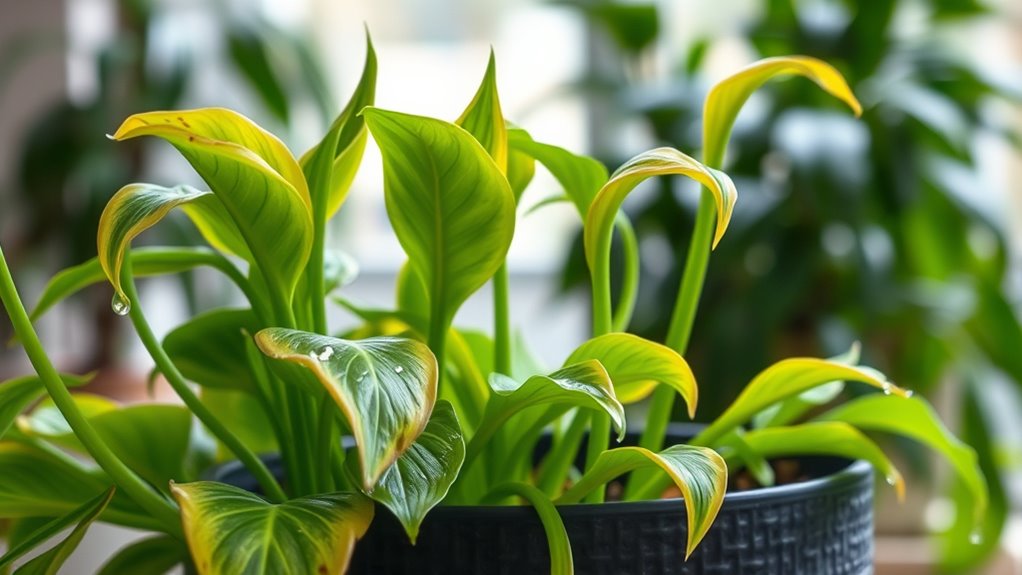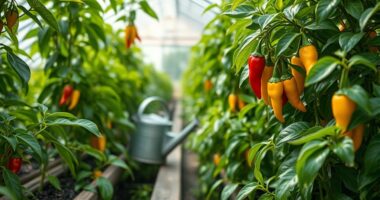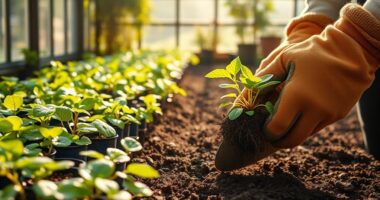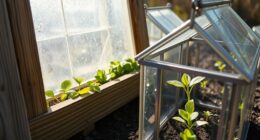When diagnosing yellow leaves or wilting, check your watering habits first—overwatering can drown roots, while underwatering dries out soil. Look for pests like aphids or spider mites, which can cause leaf issues, and treat infestations promptly. Make sure your plant gets the right light, nutrients, and consistent moisture. Carefully observe your plant’s response and adjust your care accordingly; exploring these tips can help you keep your plants healthy and vibrant.
Key Takeaways
- Check soil moisture to determine if overwatering or underwatering is causing yellow leaves or wilting.
- Inspect leaves for pests like aphids or spider mites, which can lead to yellowing and damage.
- Observe environmental conditions, ensuring proper light, humidity, and temperature for plant health.
- Review watering habits, avoiding fixed schedules; deep, infrequent watering promotes recovery.
- Address pest infestations promptly with appropriate treatments to prevent further plant stress or damage.
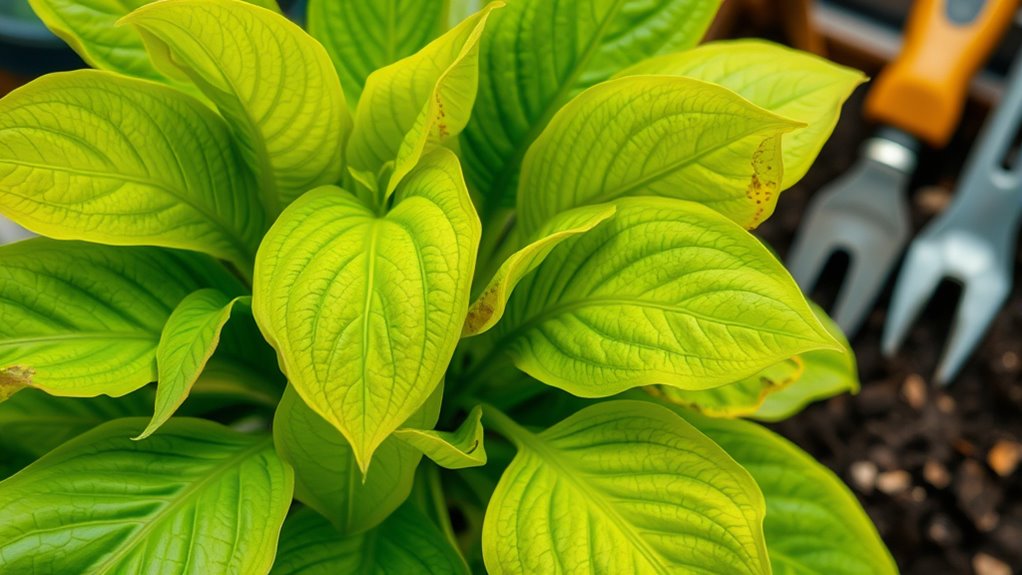
Caring for plants can sometimes be challenging, especially when they show signs of distress. One common issue you might encounter is yellowing leaves, which can be caused by a variety of factors. Often, it’s linked to watering issues—either overwatering or underwatering. If your plant’s soil feels soggy or stays wet for too long, you’re likely overwatering, which can drown the roots and prevent them from absorbing nutrients properly. Conversely, if the soil is dry and the leaves are turning yellow, your plant may need more consistent watering. To fix this, check the moisture level regularly and establish a watering routine suited to the plant’s needs. Avoid watering on a strict schedule; instead, feel the soil first to determine moisture levels. Proper watering not only prevents yellow leaves but also supports overall plant health. Additionally, understanding your plant’s specific species requirements can greatly improve its care and resilience.
Pest control is another essential aspect of troubleshooting plant problems. Pests like aphids, spider mites, or scale insects can cause leaves to yellow, wilt, or develop spots. You might notice tiny insects on the undersides of leaves or webbing around your plant. If you suspect pests, don’t delay in addressing the issue, as they can quickly spread and cause further damage. Start by isolating the affected plant to prevent pests from migrating to others. Use insecticidal soap or neem oil, applying it thoroughly to all plant surfaces, especially the undersides of leaves where pests often hide. Regularly inspecting your plants helps catch infestations early. Keep your plants healthy by maintaining proper watering and fertilizing routines, as strong plants are more resistant to pest attacks. If pests persist, consider introducing natural predators like ladybugs or using more targeted pest control methods.
Addressing watering issues and pests requires attentiveness and a bit of detective work. Observe your plant’s environment—soil moisture, leaf condition, and presence of pests—to determine the root cause of distress. Adjust your watering habits accordingly—watering deeply but infrequently helps prevent both overwatering and underwatering. Meanwhile, stay vigilant for signs of pests and act swiftly with appropriate treatments. By doing so, you’ll not only help your plant recover from current issues but also build a healthier, more resilient plant over time. Remember, consistent care and quick response are key to keeping your plants thriving. With patience and observation, you’ll become more adept at diagnosing and resolving common problems, ensuring your green companions stay healthy and vibrant.
Frequently Asked Questions
How Often Should I Water My Plant to Prevent Yellowing Leaves?
You should establish a consistent watering schedule to prevent yellowing leaves and guarantee proper plant hydration. Typically, water when the top inch of soil feels dry, which varies depending on your plant type and environment. Avoid overwatering, as it can cause root rot. Keep an eye on your plant’s condition, adjusting your watering frequency accordingly. Proper watering habits promote healthy growth and vibrant leaves, helping your plant stay strong and beautiful.
Can Overwatering Cause Wilting Even if the Soil Feels Dry?
Yes, overwatering can cause wilting even if the soil feels dry because overwatering symptoms include root rot, which hampers your plant’s ability to absorb water. Poor soil drainage traps excess moisture, leading to roots suffocating and dying, making your plant wilt despite dry-looking soil. To prevent this, guarantee proper soil drainage and avoid watering excessively, allowing the soil to dry out slightly between waterings.
What Are Natural Remedies for Yellowing Leaves?
You can try natural remedies like companion planting to improve your plant’s health and reduce yellowing leaves. Incorporate soil amendments such as compost or organic matter to boost nutrient levels naturally. These methods help balance soil conditions, encourage healthy root development, and fend off pests. By nurturing your plants with these eco-friendly techniques, you’ll promote vibrant, green foliage without relying on synthetic chemicals.
How Do I Identify if Pests Are Causing My Plant’s Problems?
To identify if pests are causing your plant’s problems, look for pest damage and insect signs. Check the undersides of leaves for tiny insects, webbing, or sticky residue. Observe if leaves are chewed or have holes, and watch for abnormal spots or mold. Regularly inspect your plant closely, and if you notice these signs, pests are likely the culprit, needing targeted treatment to restore your plant’s health.
When Should I Repot a Stressed or Wilting Plant?
You should repot a stressed or wilting plant when its current pot is too small, roots are circling or growing out, or the soil isn’t draining well. Follow a regular repotting schedule, typically every 1-2 years, to prevent issues. Before repotting, do a root health assessment—look for healthy, white roots and remove any rotted or dead ones. This helps your plant recover and thrive.
Conclusion
By understanding common issues like yellow leaves and wilting, you can confidently diagnose and care for your plants. Remember, over 70% of plant problems stem from watering mistakes or improper light. With a keen eye and timely intervention, you’ll keep your plants healthy and vibrant. So, stay attentive to your plant’s signals, and don’t hesitate to troubleshoot—it’s the key to thriving greenery in your home or garden.
